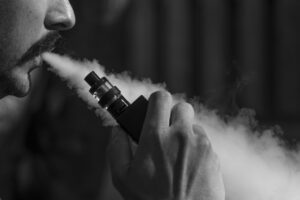Nicotine addiction is one of the most prevalent and underestimated substance use disorders in the United States, affecting millions despite decades of public health campaigns aimed at reducing nicotine use.While traditional cigarette smoking has declined over recent years, methods of nicotine consumption have evolved to include alternatives like nicotine pouches and flavored vaping products. Despite the perception by many that these are a safer alternative to smoking, these products are not without risks.
Dr. Pete Vernig, Vice President of Mental Health at Recovery Centers of America, highlighted growing concerns about these modern nicotine delivery systems during a radio interview, emphasizing how their perceived safety masks genuine addiction risk. This post examines the realities of nicotine addiction, the unique dangers posed by pouches and vapes, and outlines evidence–based treatment approaches that can help people break free from nicotine use.
What Is Nicotine Addiction?
Nicotine is one of nature’s most potent stimulants. It’s a highly addictive alkaloid compound that rapidly hijacks the brain’s reward pathways. When someone consumes nicotine, it reaches the brain within seconds, binding to nicotinic acetylcholine receptorsand triggering neurochemical changes that create both immediate pleasure and can lead to long–termphysiological dependence. The fact that nicotine is usually absorbed through the lungs or the mucous membrane of the mouth speeds up this reaction.
The addiction process centers on dopamine release in the brain’s reward system, especially within the nucleus accumbens. This dopamine surge prompts pleasurable sensations that the brain desperately seeks to repeat. This is the same pathway that makes things like food and sex enjoyable. Over time, regular nicotine exposure leads to receptor upregulation, where the brain produces additional nicotinic receptors to accommodate artificial stimulation. This adaptation creates tolerance, requiring progressively larger amounts to achieve the same effects.
Physiological dependence manifests through tolerance as well as withdrawal symptoms when nicotine levels drop. Individuals experience irritability, anxiety, difficulty concentrating, and intense cravings as nicotine’s one–to two–hour half–life creates regular withdrawal episodes throughout the day. Psychological addiction develops simultaneously, as people using the substance form behavioral associations between nicotine use and daily activities, emotions, or social situations.
Traditional vs. Modern Nicotine Delivery Systems
Cigarettes and chewing tobacco: the historical context
Traditional tobacco products dominated nicotine consumption for centuries, with cigarette smoking reaching peak prevalence in the mid–twentieth century before declining due to extensive public health interventions. The health consequences of combustible tobacco are well–established: lung cancer, heart disease, COPD (chronic obstructive pulmonary disease), and dozens of other serious conditions linked to the 7,000 chemicals produced by tobacco combustion.
Smokeless tobacco products like chewing tobacco and snuff present their own risks, including oral cancers, gum disease, and cardiovascular complications. These traditional products served as the primary gateway to nicotine addiction for generations, creating predictable patterns of dependence that healthcare providers learned to address.
Modern products reshaping the landscape
Today’s nicotine marketplace looks dramatically different, with innovative products marketed as cleaner alternatives to traditional tobacco. These modern delivery systems raise challenges both for addiction treatment and public health policy.
Nicotine pouches: the “clean” alternative
Nicotine pouches are small, spit–free pouches that contain concentrated nicotine derived from tobacco plants, along with plant fibers and flavorings. The pouches are placed under the lip, allowing nicotine absorption through oral tissues without smoking or spitting.
Dr. Vernig expresses particular concern about the perception surrounding these products. Many people view nicotine pouches as a completely safe alternative to smoking, overlooking their substantial addiction potential. Marketing campaigns often target younger demographics through social media platforms, promoting discreet use and appealing flavors.
The FDA has cleared nicotine pouches for sale but has not approved them as smoking cessation aids, distinguishing them from established nicotine replacement therapies like patches and gums. This regulatory distinction reflects a lack of long–term safety data and unresolved questions about their role in effective tobacco control strategies.
From a harm reduction perspective, nicotine pouches eliminate combustion–related toxins and reduce exposure to many carcinogens found in tobacco smoke. People using these pouches avoid lung damage associated with smoking while still receiving nicotine’s psychoactive effects. This positioning attracts people seeking potentially less harmful alternatives to cigarettes.
That said, nicotine pouches may cause some people who never smoked cigarettes to start using nicotine, especially adolescents attracted to appealing flavors and discreet usage methods.

Flavored vapes: enhanced addiction through chemistry
Electronic cigarettes have radically changed patterns of nicotine consumption, especially among teens. Vaping devices heat liquid solutions containing nicotine, propylene glycol, vegetable glycerin, and various flavorings to create inhalable aerosols. While marketed as smoking alternatives, emerging research reveals concerning addiction and health implications.
Recent animal studies led by researchers at Marshall University demonstrate that flavor additives in e-cigarettes can enhance the neurological effects of nicotine beyond what occurs with nicotine alone. Dr. Brandon Henderson, associate professor of biomedical sciences, found that certain flavors like vanilla can stimulate brain reward centers even without nicotine present. This finding suggests that flavored vaping products create addiction potential through multiple pathways.
The interaction between flavor compounds and nicotine is a significant departure from traditional tobacco products. When flavor chemicals are inhaled, they become neurologically active, potentially triggering addiction mechanisms that complicate cessation efforts. These effects may partially explain why many people find vaping more difficult to quit than traditional cigarettes.
Vaping devices also generate novel chemical compounds not found in combustible tobacco. When propylene glycol and vegetable glycerin are heated, they create unique chemicals with unknown long–term health effects. This chemical complexity renders accurate risk assessment challenging and raises questions about long–term safety assumptions.
The proliferation of nicotine–free vaping products further complicates the issue. Henderson’s research suggests that these products may still create neurological changes and addiction potential through flavor–induced brain reward activation, raising questions about current regulatory approaches and cessation strategies.
The Psychology of Nicotine Addiction
Nicotine addiction involves more than physical dependence. Behavioral triggers play a central role in driving compulsive use. Stress, social environments, boredom, and routine activities become intimately connected with nicotine use through conditioning processes. Many people develop an automatic association between specific situations and nicotine consumption, making everyday activities feel incomplete without the substance.
The conditioning process creates powerful psychological dependence as individuals pair nicotine use with coffee, driving, work breaks, social gatherings, and emotional states. These associations can persist long after physical withdrawal symptoms subside, contributing to relapse risk.
Social perception influences quitting behavior significantly. While cigarette smoking carries substantial stigma in many communities, newer products like vapes and nicotine pouches often face social acceptance, even approval. This normalization can reduce motivation to quit and create barriers to recognizing problematic patterns of use.
The Physiology of Nicotine Addiction
Nicotine’s physiological effects prompt a self-perpetuating cycle of dependence that affects multiple body systems. As a central nervous system stimulant, nicotine triggers immediate responses throughout the body while creating long–term adaptations that maintain addiction.
Upon inhalation, nicotine reaches the brain within 10 to 20 seconds, faster than many intravenous drugs. This rapid onset creates immediate reinforcement that strengthens the desire to repeat use. The substance binds to nicotinic acetylcholine receptors, mimicking natural neurotransmitters while triggering artificial reward responses.
Withdrawal symptoms typically peak within 24 to 72 hours of quitting nicotine and can persist for weeks or months. Physical symptoms include:
- Anxiety.
- Increased appetite.
- Concentration issues.
- Powerful cravings for nicotine.
Psychological symptoms often prove more demanding. These include:
- Depression.
- Mood swings.
- Sense of loss regarding familiar routines and coping mechanisms.
Long–term physiological consequences affect the cardiovascular, respiratory, and immune systems regardless of delivery method. Nicotine is a vasoconstrictor that increases blood pressure and heart rate while reducing blood flow to vital organs. Chronic exposure elevates stroke risk and accelerates the development of cardiovascular disease.
Warning Signs of Nicotine Addiction
Recognizing addiction warning signs enables early intervention and more successful treatment outcomes. Key indicators include increased frequency or urgency of use, with individuals finding themselves reaching for nicotine products more often throughout the day. Failed attempts to cut back or quit also suggest a growing addiction, especially in the event of multiple unsuccessful efforts.
Withdrawal symptoms when not using nicotine signal the development of physical dependence, often provoking people to continue using the substance to avoid these unpleasant feelings.
Using nicotine in inappropriate or risky situations indicates problematic patterns of use. This includes use at work where prohibited, in public places with restrictions, or during activities where impairment could create safety concerns.
Treatment Approaches
Effective nicotine addiction treatment requires comprehensive approaches that address both physical dependence and psychological factors. Evidence–based interventions can be highly effective when properly implemented and supported.
Behavioral treatments
CBT (cognitive behavioral therapy) often forms the foundation of effective nicotineaddiction treatment. CBT helps people identify triggers, develop alternative coping strategies, and restructure thought patterns that perpetuate addiction. Therapists work with patients to isolate high–risk situations and practice new responses that don’t involve nicotine use.
Motivational interviewing enhances treatment engagement by helping individuals explore their reasons for change. This patient–centered approach resolves ambivalence about quitting while strengthening internal motivation for recovery. This technique proves especially effective for those who feel uncertain about cessation or have experienced previous failures.
Support groups and peer programs provide ongoing encouragement and practical advice from others facing similar challenges. These connections reduce isolation while offering real–world strategies for managing cravings and maintaining abstinence during difficult periods.
Medication–assisted treatments
FDA–approved nicotine replacement therapies provide the safest approach to cessation support. Patches, gums, and lozenges deliver controlled doses of nicotine without the harmful compounds of tobacco, allowing for gradual weaning while managing withdrawal symptoms. These products double discontinuation rates when used properly under medical supervision.
Non–nicotine pharmacotherapies may also be beneficial. Bupropion, originally developed as an antidepressant, reduces nicotine cravings by affecting dopamine and norepinephrine pathways. Varenicline blocks nicotine receptors while providing partial stimulation, reducing withdrawal symptoms and smoking satisfaction.
Personalized treatment delivers the best outcomes. Adolescents require different approaches than adults, while those who use nicotine occasionally may need less intensive intervention than people who have used it heavily and long-term. Healthcare providers must assess individual needs and tailor treatment plans accordingly.
Addressing co-occurring mental health conditions improves treatment outcomes dramatically. Depression, anxiety, and other psychiatric disorders often complicate nicotine addiction, requiring integrated treatment approaches that address all conditions simultaneously.
Complementary and emerging approaches
Mindfulness techniques help individuals manage stress and cravings without nicotine use. Regular practice develops awareness of thoughts and feelings while building capacity to tolerate discomfort without automatic reactions.
Exercise provides natural mood enhancement while reducing stress and anxiety that often trigger nicotine use. Physical activity also helps manage weight gain commonly associated with cessation, addressing a major barrier for many people looking to quit nicotine.
Digital tools expand access to support and intervention. Quit smoking apps, text-based coaching programs, and telehealth services provide convenient resources for maintaining motivation and accessing professional guidance when needed.
Emerging Concerns & Public Health Implications
Marketing strategies for nicotine pouches and flavored vapes increasingly target younger demographics through sophisticated social media campaigns that minimize nicotine addiction risks while highlighting supposed lifestyle benefits.
Regulatory frameworks struggle to keep pace with product innovation, creating dangerous gaps in oversight and consumer protection. FDA flavor restrictions on traditional cigarettes have prompted manufacturers to shift toward alternative products with fewer regulatory constraints, undermining public health gains achieved through tobacco control efforts.
Youth initiation rates for contemporary nicotine products exceed historical patterns for traditional tobacco, suggesting that perceived safety and aggressive marketing are successfully attracting those who might otherwise have remained tobacco-free.
Long-term health risks for emerging products remain largely unknown due to limited research timeframes. While manufacturers promote safety claims, comprehensive studies examining decades of use simply don’t exist yet, leaving individuals to participate in uncontrolled experiments with their health.

How to Seek Help
Nicotine addiction is a treatable medical condition, not a personal failure or character flaw. Recovery is possible at any age or stage of addiction, and professional support significantly improves success rates compared to unassisted attempts at quitting.
Quitting nicotine improves health immediately and continues providing benefits for years after cessation. Heart rate and blood pressure decrease within hours, while circulation improves, and lung function increases within weeks. Long-term benefits include sharp reductions in cancer, heart disease, and stroke risks.
Conclusion
Nicotine addiction and nicotine dependence continue to evolve as innovative products reshape consumption patterns and challenge traditional treatment approaches. While nicotine pouches and flavored vapes may eliminate some risks associated with combustible tobacco, they introduce new dangers through enhanced addiction potential and unknown health consequences.
For immediate help with addiction and mental health challenges, contact Recovery Centers of America at 1–800–RECOVERY. Our compassionate team is available 24/7 to provide guidance, support, and hope for lasting recovery.
